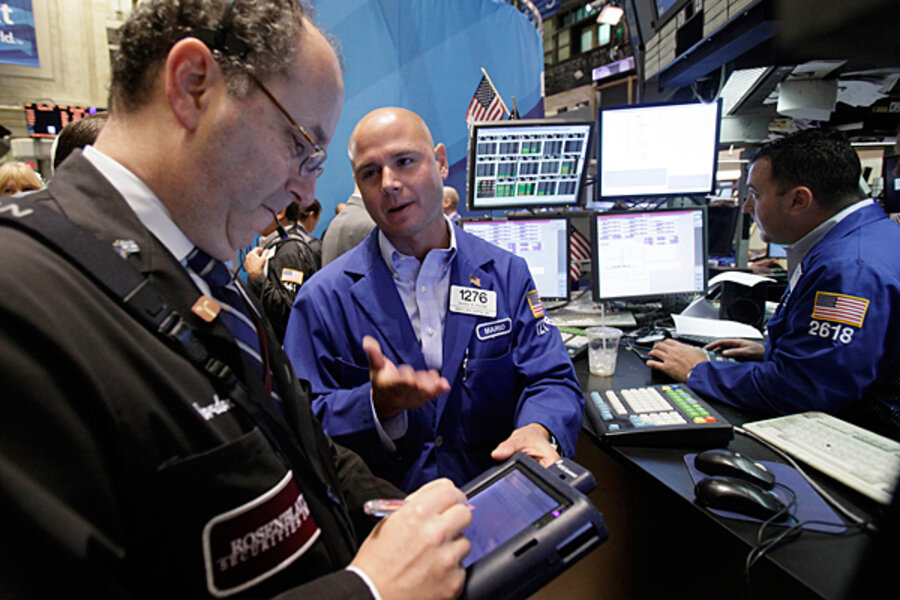Why debt-ceiling deal didn't give stock markets a bigger boost
Loading...
| New York
One of the major reasons Congress and the president felt compelled to reach a deal on the debt ceiling was a fear that the financial markets would falter if the US defaulted on its debt.
On Monday, the stock market greeted the news of the debt compromise with a rise that lasted eight minutes. Then, the economic realities intruded with some data indicating that July may have been yet another month of little growth.
Almost immediately, the US dollar fell compared to such currencies as the Swiss franc and the yen. And, the stock market swooned as well.
The Dow Jones Industrial Average, which opened at 12,144, initially rose to 12,282 before slumping at midday to 11,998. A midafternoon rally cut most of those losses, lifting the Dow to 12,115, off 28 shortly after 3:15 p.m.
The drop in the Dow follows a loss of about 500 points over the past week – the largest loss in more than a year – as investors worried that the Republicans and Democrats would be unable to compromise, resulting in a default by the US government.
Once a tentative deal was announced, some traders said they were relieved – at least for the moment.
“I would say that something is better than nothing,” says Eric Stein, vice president and portfolio manager at Eaton Vance Investment Managers in Boston. “The combined cuts in the deficit of about $2.5 trillion over ten years is a small step in the right direction,” he says. “But, it’s not a panacea by any stretch of the imagination.”
Some investors in fact never had any doubt the politicians would reach an agreement of some sort. “The financial markets always knew there would be no default on the debt,” says Lance Roberts, an economist with the firm Streettalk Advisors, based in Houston. “If they had been worried, interest rates would be north of 4 percent, probably closer to 5 percent, and the market would have been down 15 percent.”
Of greater concern is the economy, says Mr. Roberts whose own economic indicators suggest the US will be in a recession again early in 2012. “Everything is deteriorating,” he says.
On Monday, that was the message economists read into the July Institute of Supply Management (ISM) survey which showed growth slowing in many sectors. For example, the ISM manufacturing index declined from 55.3 to 50.9. Anything above 50 indicates the economy is growing. However, some aspects of the report, including new orders, inventories and backlog of orders all contracted and in some cases shrank at a faster rate.
Roberts says the economic conditions are similar to 2010 when the Federal Reserve purchased $600 billion in long term Treasury bills to push interest rates lower and stimulate the economy. That program, termed “Quantitative Easing II,” or QE2, expired this June.
“My expectation is the Fed will get a tap on the shoulder by the administration,” says Roberts, who is also a conservative broadcaster. “The president will say, ‘I can’t go into campaign mode with unemployment approaching 9.5 percent and the economy growing at near zero.’ ”
However, maybe investors are reading too much into the sagging market, says Clark Hodges of Hodges Capital in Dallas.
“We are in the summer doldrums,” he says. “There are some sellers but not a lot of buyers. The next few weeks, the drag will be down.”
Mr. Hodges expects investors to get back into the swing of things after Labor Day. “People will start to assess the Christmas and retail environment,” he says.
However, by this fall, investors may also be watching Washington again. The current deal announced by the president and Congress only extends the government’s borrowing authority, it does not include money appropriated to pay for government programs in Fiscal Year 2012 other than a numerical cap on spending.
“I am expecting the Republicans to come back and say they want more spending cuts, that they don’t care what’s in the agreement,” says Stan Collender, a partner at Qorvis Communications in Washington and a budget expert. “I don’t think they will do it once, but do it monthly,” he says.
This leads some investors to let out a huge groan.
“This means another market volatility-inducing budget battle is on tap for early this fall,” writes Jeffrey Kleintop, chief market strategist at LPL Financial, an independent broker based in Boston, in an analysis. “And the vote by Congress on finding … the second, $1.5 trillion round of spending cuts and boost to the debt ceiling, is set for Dec. 23.”





